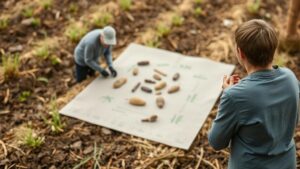Researching Old Coin Circulation Maps for Buried Treasure
Researching Old Coin Circulation Maps for Buried Treasure
The quest for buried treasure has captivated the human imagination for centuries. Among the myriad of strategies employed by treasure hunters, one of the most intriguing is the research of old coin circulation maps. This practice is rooted in the understanding of historical economic systems and social behaviors, where coins served not merely as currency but as artifacts of civilization. This paper examines the significance of these maps in locating potential buried treasures, providing empirical evidence, and outlining methodologies for effective research.
The Historical Context of Coin Circulation
Coins have been used as a medium of exchange since their introduction in Lydia (modern-day Turkey) around 600 BCE. Historical records reveal that coins were not uniformly distributed and their circulation was heavily influenced by trade routes, political stability, and local economies. For example, during the Roman Empire, coins traveled vast distances, reflecting the empire’s economic influence in regions like Gaul and Britania.
Understanding Coin Circulation Maps
Coin circulation maps are visual representations that depict the flow of coins through various regions over specific periods. e maps can indicate where coins were minted, how they were traded, and their ultimate fate–whether they remained in circulation or were buried. Notable examples include:
- The early 18th-century British coin maps that illustrate trade between the American colonies and Britain.
- The Spanish colonial coin maps from the 16th century demonstrating the spread of silver pesos throughout Latin America and their subsequent circulation in Europe.
Insights from Archaeological Evidence
Archaeological findings play a crucial role in supporting the hypotheses derived from coin circulation maps. For example, in 1857, the SS Central America sank, carrying approximately 3,200 gold coins. later discovery of these coins and their mint marks matched with contemporary circulation records provides proof of their journey and burial context.
Similarly, the discovery of buried caches of coins from various erudite studies illustrates historical currency practices. The excavation at Fort Ticonderoga unearthed over 2,000 coins from the 18th century, showcasing the areas importance as a trade route and military post.
Methodologies for Researching Coin Maps
To effectively utilize coin circulation maps for treasure hunting, researchers can employ the following methodologies:
- Historical Analysis: Investigate historical texts and property records from the target area to establish a timeline of coin usage and circulation.
- Geospatial Analysis: Use Geographic Information Systems (GIS) technology to overlay historical maps with modern topography, allowing for the identification of locations likely to have been used for coin storage.
- Community Engagement: Collaborate with local historians and archaeologists who may have knowledge of undocumented treasure troves or citizen reports of metal detection findings.
Case Studies and Examples
Several case studies exemplify the successful application of research into coin circulation maps. One such case is the Great Indiana Gold Hoard, unearthed in the early 1990s during construction work. Researching coin circulation maps related to the region indicated an influx of gold coins during the Gold Rush period, guiding treasure hunters to the likely locations for treasure recovery.
Another notable instance is the discovery of ancient Roman coins at the site of a former villa in England, where circulation maps indicated that this area was a hotbed for economic activity in the 1st century AD. This discovery not only provided insight into the trading patterns of the time but also highlighted the potential for further finds in similar locales.
Potential Challenges and Ethical Considerations
While the potential for discovering buried treasure through research is significant, it is not without challenges. Ethical considerations must guide this endeavor, especially regarding land ownership and archaeology. Unauthorized excavations can damage historical sites and lead to legal repercussions.
Actionable Takeaways
For aspiring treasure hunters and historians interested in utilizing old coin circulation maps, consider the following actionable steps:
- Conduct thorough research on historical currency practices in your region of interest.
- Use both digital and physical archives to gather comprehensive data regarding old coin distributions.
- Engage with local museums and historical societies for access to specialized resources and expert knowledge.
- Get involved in community archaeology projects to network with like-minded individuals and contribute to preserving historical sites.
Through the diligent study of coin circulation maps, future treasure seekers can unlock the secrets of the past, revealing lost troves that reflect the complex tapestry of human history.



